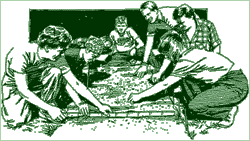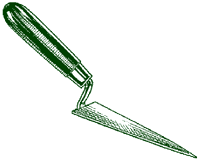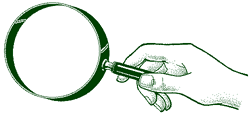 |
|
|||
Materials Shovels, trowels, paint brushes, stakes, string, journals, pens, items to use as artifacts; rocks, eating implements, small bottles, piece of pottery, beads, money, piece of glass (suggest sea glass without sharp edges), metal –– depending on the direction you may wish the students’ "stories" and interpretation to lead Making Connections
Background Excerpts from Archeology for the Young original activity submitted by Gretchen Brown The plot had been located, and the new student archaeologists at Woodland Country Day School were ready to start. They understood about sectioning off the earth, with each one working on his own area. They knew that they had to use their tools carefully; they were not to rush and hurry. They were looking for signs of earlier civilizations. They realized that this spot might reveal artifacts from several centuries. Excitement ran high as they approached the dig. Imagine their feelings when they found that the dig had already been disturbed. The feeling of disappointment was greatest, for these were beginners and this was to be their first dig. Then came anger, personal anger. How could someone do this to them? Now they wouldn’t be able to assemble the clues to the past. Most of us can relate to these feelings. Sites have been looted, inadvertently or otherwise. While it is understandable that people want to pick up an intriguing object found in their path, they need to be taught at an early age to respect the integrity of historical data and why it is not a good idea to take found objects. (For example, if along the river bank there are ten pottery shards that appear ancient, and each of nine people takes one, by the time the tenth person comes along and takes the last piece, you have completely lost something that might have been a key in understanding the area.) Without the supervision of a trained archaeologist digging for relics is an especially damaging practice. Many river banks throughout Southern New Jersey are unearthed by naive persons who ultimately destroy any chance of acquiring knowledge about Native Americans. The position in which objects are found in relationship to each other is particularly important to assembling assumptions about the past. Many local archeological remains have been destroyed by development. An Indian camp was destroyed by the construction of Route 55, without any prior archeological investigation. Conversely a different site was investigated for historical significance before construction, thus some information was derived. As teachers, it would appear that we need to teach our children to respect these cultural resources. Considering how long it has taken to teach children about caring for their environment, i.e., littering and pollution, it may take us many years to teach this new concept of “don’t touch, don’t disturb.” But we have to begin sometime or we will have lost countless examples of historical information. If the vandals who destroyed the “Arch” in Utah had been trained from childhood to respect these national treasures, one hopes that this destruction would never have occurred. Theoretically, taking a pottery shard is just as bad as destroying the Arch in terms of the valuable information derived from qualified examination. But, you ask, how can children be taught about the importance of historical knowledge, when it is such a temptation to take a piece of history home? This is a difficult question. We can expose our children to exhibits and museums, and we can provide slides and videos, but we have limitations in providing children with a hands-on experience: an experience that might foster an interest in pursuing a career in archaeology, or at least respecting artifacts. Perhaps your local historical society or museum has available to you a traveling exhibit of core artifacts — artifacts which have been professionally examined and catalogued so your students could actually feel and study the objects up close. Procedure
The Activity
Wrap Up Review journal entries. Discuss conclusions made about peoples from objects found and relationships of objects to other objects. Discuss stratigraphy of the site. Write a story about the unidentifiable object. What does the student suppose the purpose of the object was? What is it made of? Why would prehistoric settlements border rivers? Why would Indian remains be more prevalent on high ground areas adjacent to rivers? Why would Indians go to the shore in the summers? What may be deduced from what’s not present? Creative writing assignment about unidentified objects’ presumed purpose. Extensions Mrs. Brown’s class was disappointed when they discovered their site had been disturbed, just as many archaeologists have been devastated and thwarted by looters. This unplanned event presents an opportunity to discuss the damage done by untrained or greedy persons. Why not make one mock looted site and one plentiful site. This way students can experience the frustration of sites that are disturbed or destroyed. Have the students use the painstaking mason trowels and brushes that archaeologists utilize to uncover small layers at a time. Layers can be devised to correlate to time periods; stone tools, points, pottery, glass, buttons, metal, plastic, transistor, a computer chip… limited only by your imagination. The layers could be more specific to a time period being studied in class. Some class time should be spent discussing stratigraphy. In general older objects would be found at deeper depths. Discuss what might alter this placement; plowed fields, frost, earthquakes, floods, tree roots, dumps, construction… NEVER USE A KNOWN ARCHEOLOGICAL SITE FOR AN EXCAVATION. Another possible extension is to have students imagine what we (today’s society) would leave behind. Most of what we throw away ends up in a sanitary landfill that is buried with a layer of soil every day (much like the stratified layers that actually exists in nature.) What clues to our life-style would a student 100, 200, 300, 400 years from now find? A cross-sectional drawing/diagram could be made to show the various "artifacts" that such a site would include. Please download the PDF for the complete Lesson Plan. Books by Herbert Kraft listed in reference materials Historic Themes and Resources book pages 4, 39, 57, 109. The Turtle Stone, The Legacy of the Abbott Farm video and Teacher’s Study Guide were developed to teach 4th through 8th graders about archeology. It focuses on the history and way of life of the Lenape Indians, the philosophy and practice of archeology, prehistoric artifacts found at the farm of Dr. Charles Abbott and the part they played in New Jersey history, and the roles of citizens and government in managing our cultural resources. For more information contact: |
|||

 and its tributaries in the region called "Down Jersey."
and its tributaries in the region called "Down Jersey." Objectives
Objectives Native Americans were the first to make use of the fertile shores of the Delaware Bayshore. Their use of the local resources and what later evolved into colonial use has a connection to present day applications. Today there are many archaeological sites along the Bay and its tributaries. Many of these sites have been excavated by untrained curiosity seekers. As a result the knowledge that could be gained by expert inspection has been lost. A number of locations have been expertly excavated and have yielded insights into the Lenape or Delaware Indians.
Native Americans were the first to make use of the fertile shores of the Delaware Bayshore. Their use of the local resources and what later evolved into colonial use has a connection to present day applications. Today there are many archaeological sites along the Bay and its tributaries. Many of these sites have been excavated by untrained curiosity seekers. As a result the knowledge that could be gained by expert inspection has been lost. A number of locations have been expertly excavated and have yielded insights into the Lenape or Delaware Indians. Warm Up
Warm Up